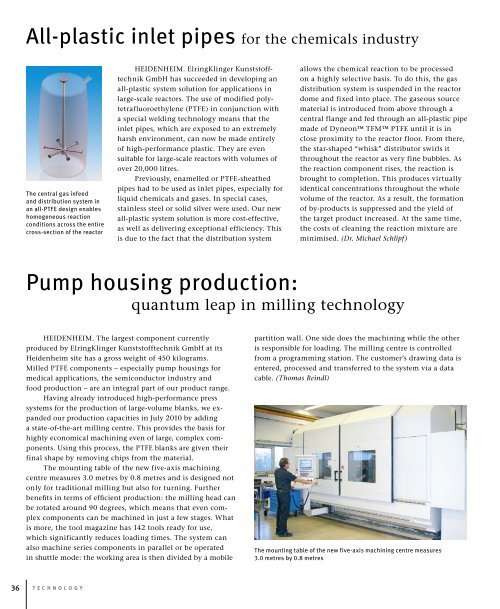THE STAFF MAGAZINE OF THE ELRINGKLINGER GROUP NO. 1 ...
THE STAFF MAGAZINE OF THE ELRINGKLINGER GROUP NO. 1 ...
THE STAFF MAGAZINE OF THE ELRINGKLINGER GROUP NO. 1 ...
Create successful ePaper yourself
Turn your PDF publications into a flip-book with our unique Google optimized e-Paper software.
All-plastic inlet pipes for the chemicals industry<br />
The central gas infeed<br />
and distribution system in<br />
an all-PTFE design enables<br />
homogeneous reaction<br />
conditions across the entire<br />
cross-section of the reactor<br />
Pump housing production:<br />
quantum leap in milling technology<br />
36 TECH<strong>NO</strong>LOGY<br />
HEIDENHEIM. ElringKlinger Kunststofftechnik<br />
GmbH has succeeded in developing an<br />
all-plastic system solution for applications in<br />
large-scale reactors. The use of modified polytetrafluoroethylene<br />
(PTFE) in conjunction with<br />
a special welding technology means that the<br />
inlet pipes, which are exposed to an extremely<br />
harsh environment, can now be made entirely<br />
of high-performance plastic. They are even<br />
suitable for large-scale reactors with volumes of<br />
over 20,000 litres.<br />
Previously, enamelled or PTFE-sheathed<br />
pipes had to be used as inlet pipes, especially for<br />
liquid chemicals and gases. In special cases,<br />
stainless steel or solid silver were used. Our new<br />
all-plastic system solution is more cost-effective,<br />
as well as delivering exceptional efficiency. This<br />
is due to the fact that the distribution system<br />
HEIDENHEIM. The largest component currently<br />
produced by ElringKlinger Kunststofftechnik GmbH at its<br />
Heidenheim site has a gross weight of 450 kilograms.<br />
Milled PTFE components – especially pump housings for<br />
medical applications, the semiconductor industry and<br />
food production – are an integral part of our product range.<br />
Having already introduced high-performance press<br />
systems for the production of large-volume blanks, we expanded<br />
our production capacities in July 2010 by adding<br />
a state-of-the-art milling centre. This provides the basis for<br />
highly economical machining even of large, complex components.<br />
Using this process, the PTFE blanks are given their<br />
final shape by removing chips from the material.<br />
The mounting table of the new five-axis machining<br />
centre measures 3.0 metres by 0.8 metres and is designed not<br />
only for traditional milling but also for turning. Further<br />
benefits in terms of efficient production: the milling head can<br />
be rotated around 90 degrees, which means that even complex<br />
components can be machined in just a few stages. What<br />
is more, the tool magazine has 142 tools ready for use,<br />
which significantly reduces loading times. The system can<br />
also machine series components in parallel or be operated<br />
in shuttle mode: the working area is then divided by a mobile<br />
allows the chemical reaction to be processed<br />
on a highly selective basis. To do this, the gas<br />
distribution system is suspended in the reactor<br />
dome and fixed into place. The gaseous source<br />
material is introduced from above through a<br />
central flange and fed through an all-plastic pipe<br />
made of Dyneon TFM PTFE until it is in<br />
close proximity to the reactor floor. From there,<br />
the star-shaped “whisk” distributor swirls it<br />
throughout the reactor as very fine bubbles. As<br />
the reaction component rises, the reaction is<br />
brought to completion. This produces virtually<br />
identical concentrations throughout the whole<br />
volume of the reactor. As a result, the formation<br />
of by-products is suppressed and the yield of<br />
the target product increased. At the same time,<br />
the costs of cleaning the reaction mixture are<br />
minimised. (Dr. Michael Schlipf)<br />
partition wall. One side does the machining while the other<br />
is responsible for loading. The milling centre is controlled<br />
from a programming station. The customer’s drawing data is<br />
entered, processed and transferred to the system via a data<br />
cable. (Thomas Reindl)<br />
The mounting table of the new five-axis machining centre measures<br />
3.0 metres by 0.8 metres




